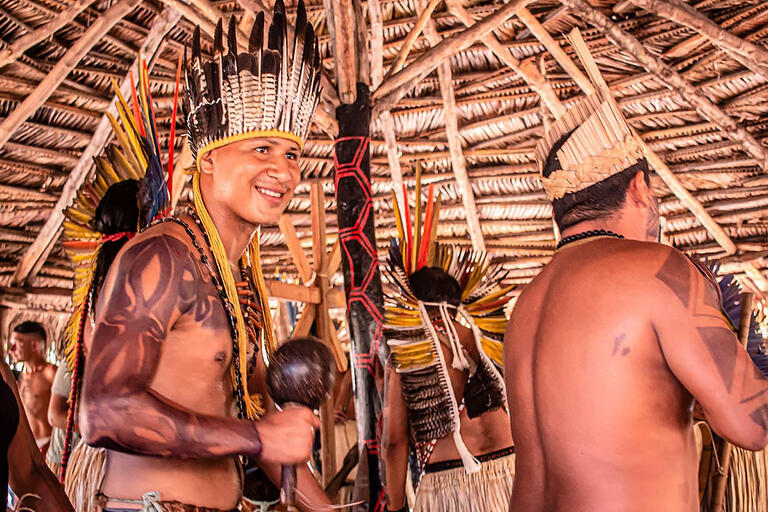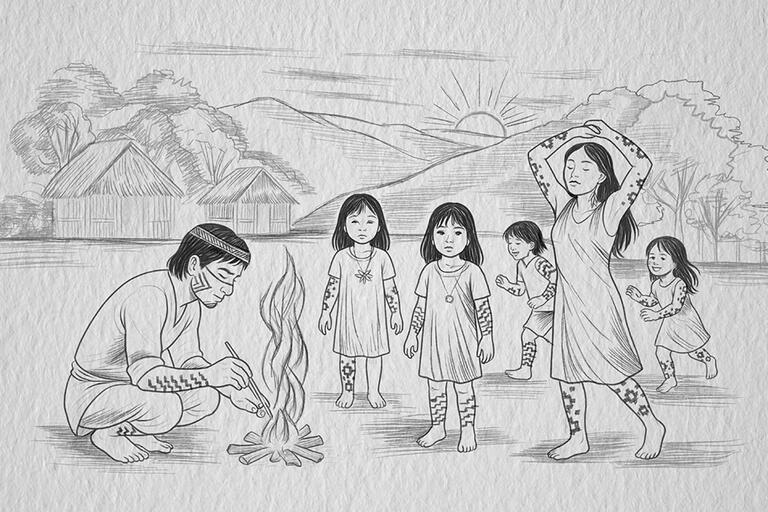CLACS is proud to be a part of Revista Pihhy, a collaboration with the Núcleo Takinahakỹ de Formação Superior Indígena at the Universidade Federal de Goiás and the Secretaría de Formação, Livro e Leitura at the Ministério da Cultura in Brasilia, that focuses on knowledge production by Indigenous people in Brazil.
CLACS will publish English-language translations from the Brazilian journal by the Coletivo de Tradutores Berkeley-Brasil.
Sign up to receive notice when new articles are published.
Revista Pihhy Articles in English

Nhandereko, the Guarani Law (with audio annotations)
By Vilmar Guarany
Translated by Coletivo de Tradutores Berkeley-Brasil
The author, a Myba Guarani lawyer and university professor with a doctorate in social anthropology, argues for a deeper conception of Indigenous Peoples’ law systems, proposing understanding Nhandereko not merely as Guarani ‘customs,' but as wholistic law. Nhandereko should be recognized as a sphere of sovereign, self-determined political-social order on an internal and international legal stage.
Nhandereko, the Guarani Law (pdf 1.4 MB)
Nhandereko, o Direito Guarani (pdf 9.0 MB)

Damsõkẽkwa (with audio annotations)
By Ercivaldo Damsõkẽkwa Xerente
Translated by Coletivo de Tradutores Berkeley-Brasil
In the first chapter of his doctoral dissertation, the author recounts the institutional as well as personal obstacles that he faced during his academic trajectory as a Xerente akwẽ person in Tocantins and Goiás. His project focuses on the relationship between traditional Xerente akwẽ educational systems and school education models as they are currently practiced according to Brazilian educational policy, with the purpose of understanding these processes in their complexity.
Damsõkẽkwa (pdf 1.4 MB)

CARÕ ME: Drawing Experience in the School Courtyard (with audio annotations)
By José Alecrim
Translated by Coletivo de Tradutores Berkeley-Brasil
The author reflects on his upbringing and education in the state of Goiás. In school, he was taught negative stereotypes of Indigenous peoples. He now works as an educator in the state’s school network, where he contributes to a traveling art exhibit that uses drawing and visual art to teach school communities about Indigenous issues.
CARÕ ME: Drawing Experience in the School Courtyard (pdf 2.0 MB)
CARÕ ME: Uma Experiência de Desenho no Pátio da Escola (pdf 6.3 MB)

Wato ne hômpu ne kãmpa: I live, I see, and I hear Mehi (with audio annotation)
By Creuza Prumkwyj Krahô
Translated by Coletivo de Tradutores Berkeley-Brasil
In "I live, I see, and I hear Mehi (Mãkrarè) life," Creuza Prumkwyj Krahô describes the practice of the resguardos, the traditional methods of deep reflection that safeguard Krahô knowledge, and how Krahô women preserve this knowledge as men migrate to urban areas.
Wato ne hômpu ne kãmpa: I live, I see, and I hear Mehi (Mãkrarè) life (pdf 576 KB)

Espíritos da Terra: Um Encontro no Cerrado (Spirits of Earth: An Encounter in the Cerrado)
By Ana Maria Kariri
Translated by Coletivo de Tradutores Berkeley-Brasil
The author tells the story of Araña, a young Xucuru Kariri warrior, whose deep connection with nature and his burning desire to preserve the traditions of his ancestors reflect the struggle of Indigenous peoples seeking to keep their cultural identities alive.
Espíritos da Terra: Um Encontro no Cerrado (Spirits of Earth: An Encounter in the Cerrado) (pdf 3.3 MB)

Potiguara Ethnohistory
By Kaberekoara Potiguara (Dom Ezequiel Maria Potiguara)
Translated by Coletivo de Tradutores Berkeley-Brasil
The author endeavors upon an Indigenous re-reading of historical sources — from sixteenth-century chronicles to recent testimony — to redress ignorance of the vast extent of Potiguara territory and persistence of their language. Part of a life-long project conceived as “Potiguara Collection: Memory of a Nation,” the author abundantly evidences and affirms: “The Potiguara have history!”
Potiguara Ethnohistory (pdf 2.3 MB)

A festa dos animais (The Animal Party)
By Vangri Kaingang
Translated by Coletivo de Tradutores Berkeley-Brasil
The author relates a story of the Kaingang culture: while harvesting corn, three children encounter a party of animals, dancing and playing instruments around a fire. The children join in, transforming into animals themselves. After returning to their village, they tell the elders of the night’s events, and the village reenacts the party to attract the animals and share in another night of celebration.
A festa dos animais (The Animal Party) (pdf 7.2 MB)

MẼ IXPAPXÀ MẼ IXÀHPUMUNH MẼ IXUJAHKREXÀ: Territory, Knowledge and Ancestrality in the Panhĩ School Education Processes
By Julio Ribeiro Kamêr Apinajé
Translated by Coletivo de Tradutores Berkeley-Brasil
The author reports on how the transmission of oral culture, through the Panhĩ musicality inherited from their ancestors, is essential in the understanding and resistance of Panhĩ Apinajé culture. He also argues about the importance of traditional singing in the education of Indigenous youth and how this impacts the preservation of Indigenous cosmology.

Forest Psychology: Mental Health in Kanhgág Perspective
Translated by Coletivo de Tradutores Berkeley-Brasil
The author reflects on how practices of mental health and cure have long been present in ancestral Kanhgág body-territories. Emphasizing the centrality of Indigenous territory, demarcation, and cosmoperception to collective futures, a specifically Kanhgág forest psychology disrupts the “supposedly universal knowledge of coloniality” and urges the non-Indigenous (fóg) to hear and join Indigenous struggle.
Forest Psychology: Mental Health in Kanhgág Perspective (pdf 300 KB)

TAKÃRA: Epistemological Center and Cosmic Communication System for the Cultural Vitality of the Apyãwa World
By Gilson Ipaxi’awyga Tapirapé (Tenywaawi)
Translated by Coletivo de Tradutores Berkeley-Brasil
Tenywaawi tells us about his educational history and his return to Apyãwa epistemology. In this, he emphasizes the centrality of the Takãra for the epistemological and socio-cultural sustenance of the Apyãwa people.
TAKÃRA: Epistemological Center and Cosmic Communication System for the Cultural Vitality of the Apyãwa World (pdf 7.7 MB)

Suri (Happy in Nheengatu) and Pimenta, the Sloth
By Bete Morais
Translated by Coletivo de Tradutores Berkeley-Brasil
In the stories "Suri (Happy in Nheengatu)" and "Pimenta, the Sloth," Bete Morais explores the relationship between people, beings, and territory based on the ancestral knowledge of the Indigenous communities of the Alto Rio Negro.
Suri (Happy in Nheengatu) and Pimenta, the Sloth (pdf 7.3 MB)
SURI (Feliz em nheengatu) e A PREGUIÇA PIMENTA (pdf 4.7 MB)

"Where are Your People's Instruments?"
By Glicéria Tupinambá
Translated by Coletivo de Tradutores Berkeley-Brasil
The author narrates her journey to find her people’s musical instruments, which were expropriated from the Tupinambá and hidden away in European museums and private collections. Following guidance from her dreams, the Encantados, and the ancestral knowledge of her people, Glicéria shares the centrality of sensible listening in her search through opaque colonial collections.
"Where are Your People's Instruments?" (pdf 2.5 MB)

PATHS OF ANCESTRY: Sustaining Kaingang Epistemological Existences
By Bruno Ferreira
Translated by Coletivo de Tradutores Berkeley-Brasil
This article explores the relationship between Indigenous ancestral knowledge, particularly of the Kaingang, and education in Indigenous schools, with the aim of acknowledging the methodologies and practices of the Kaingang people. This knowledge, which is founded upon ancestral space-times, is shared and constructed by the lived experiences of all members of the community and, the author argues, may open new pathways to education.
Paths of Ancestry (pdf 5.5 MB)

